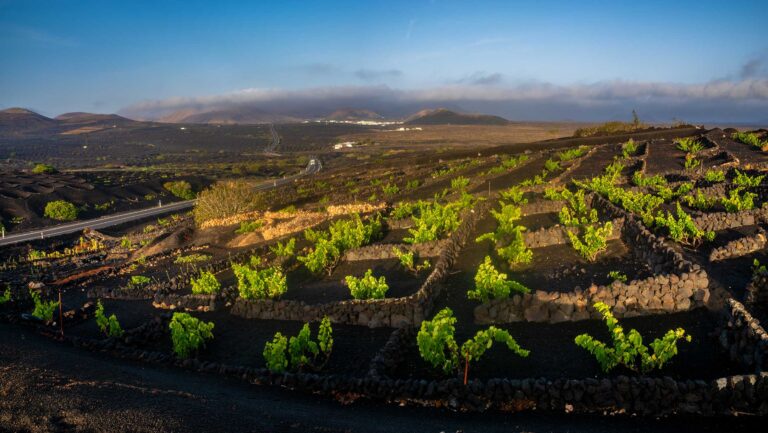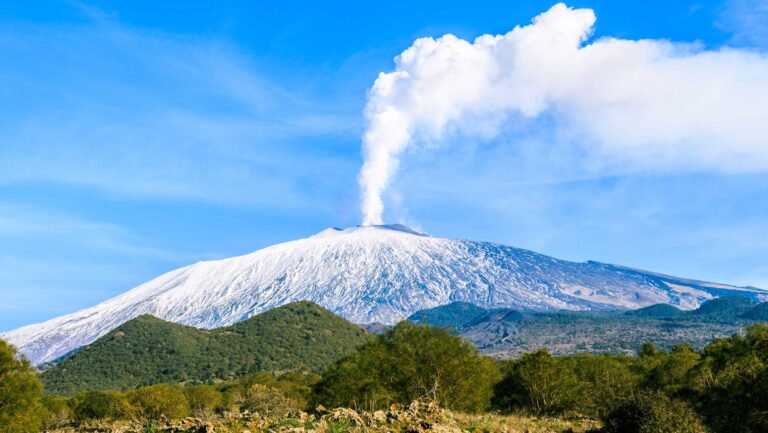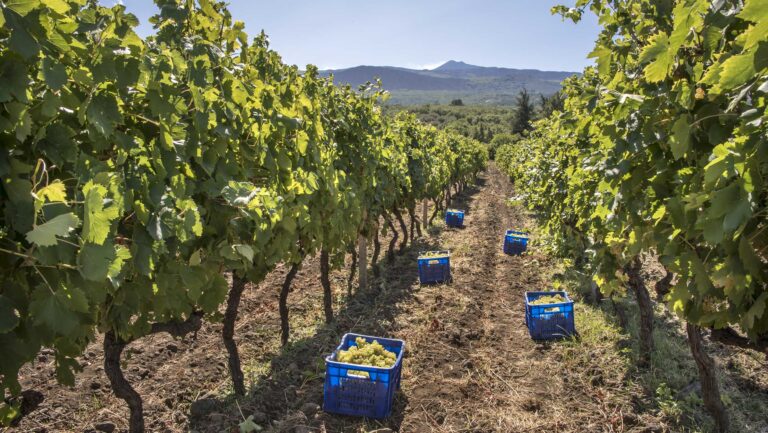From Etna to the Canary Islands, volcanic wines have garnered a lot of attention in recent years. But what distinguishes volcanic soil, and how does it impact a resulting wine?

At the fourth International Volcanic Wine Conference (IVWC) in June 2024, representatives of almost 70 wineries from Sicily to Santorini congregated in New York City to talk about the highs and lows of making wine in the shadow of one of the world’s most unpredictable landforms.
“Anywhere you have active volcanoes are some of the most unique places in the world because every year, you gain five to 10 millimeters of new soil from eruptions,” says Giovanni Gaja, who makes wines under a joint venture with the Graci family called IDDA in the villages of Belpasso and Biancavilla, which sit on Mount Etna’s southern slopes. “For us, [making wine on] Etna meant we had to adapt to a completely different world from Brunello, Barbaresco, and Montalcino.”
But despite the most famous examples, not all volcanic soils are located near active volcanoes. Some exist as the result of lava flows from millions of years ago, which have weathered over time.
“Volcanoes erupt a huge range of compositions under a large range of conditions, that then weather under a range of climate conditions to create a wide variety of soil types,” explains Kevin Pogue, Ph.D., a professor of geology at Whitman University whose research focuses on terroir. “A ‘volcanic soil’ could be formed in a humid environment by deep weathering of a basaltic lava to create an iron-rich red clay soil, [such as] Jory soil in Willamette Valley, or one could be formed in relatively unaltered pyroclastic material near an active volcano in a very dry climate [like] Lanzarote [in the] Canary islands.”
Wines produced from grapes grown on volcanic soils—often dubbed “volcanic wines”—are increasingly capturing the attention of drinkers who seek complex wines with vibrant acidity, minerality, and, in many cases, slightly smoky notes. How are producers around the world harnessing the unique strengths (and managing the challenges) of these soils to make vibrant, terroir-driven wines?
Growing Volcanic Vines
One of the most prominent characteristics of sand and rock-dominant volcanic soil is the abundance of nutrients; each time a volcano erupts (which, in the case of Mount Etna, can be over 50 times per year), the soil composition shifts under the pressure of hot lava and fresh rock that surfaces from the earth’s core. It’s a double-edged sword: The recent presence of ash or lava makes soil more acidic and less fertile, while the ample supply of minerals like iron, sulfur, and magnesium makes soils more fertile.
But fertility doesn’t necessarily make a winemaker’s job easier.
“Volcanic soils are generally well-draining, which means that these nutrients quickly dissolve and aren’t easily accessible to vines,” explains John Szabo, MS, the organizer of the IVWC and author of Volcanic Wines: Salt, Grit and Power. “It’s kind of like a giant buffet that they can only look at from afar.”
While the natural presence of macro and micronutrients is a net positive, these soils’ high content of basalt and sand, as opposed to water-retaining materials like clay, loam, and limestone, pose a challenge for both winemakers and their vines.
“[Because volcanic soils] often do not retain water as efficiently … the vines have to work harder and adapt. This stress can result in lower yields but potentially higher-quality grapes with more concentrated flavors,” says Antonio Rallo, the fifth-generation CEO and co-owner of Sicilian winery Donnafugata, which manages five estates, including ones on the volcanic island of Pantelleria and the northern slopes of Mount Etna.

Better drainage means protection from rot and fungal growth, but that doesn’t mean winemakers can sit back and relax.
“These soils are very energetic, and we must manage that energy,” explains Gaja. “In Barbaresco and Tuscany, for example, we work with compost. For [volcanic] soils, we don’t add compost, because we don’t want to add onto that energy.” To trap water and keep the high-drainage, sandy soils from effectively “sliding down” the steep slopes in Biancavilla on Etna’s southwestern face, vines are terraced, he adds.
Most volcanic soils have a relatively high amount of acidity—in other words, a low pH level—as well, though Pogue notes that this isn’t universal. “Soil chemistry is a result not only of the bedrock from which the soil is derived,” he says, “but the processes and environment that produce the soil, so the chemistry, including the pH of soils derived from volcanic rocks, will vary substantially depending on the site and its climate.”
Acidic soils can complicate a vine’s ability to absorb nutrients, which can lead to less vigorous canopy growth and smaller clusters of fruit, as well as smaller berries. In the best cases, this stress from nutrition limitations—as well as water limitations—can lead to wines with serious aging potential. “This tends to reduce the vine’s yield but enhances the quality and concentration of the grapes [which] can result in wines with a higher level of complexity, structure, and depth,” says Rallo.
The Essence of Volcanic Wine
It is important, however, to remember that volcanic soils are not a monolith, especially when it comes to how they manifest in wine.
Firstly, these soils could be formed by the weathering of the products of many different types of eruptions, including lava flows, pyroclastic flows (very hot, high-speed mixtures of rock, gas, and ash), and lahars (mudflows of water and volcanic debris). They could also be formed from volcanic products of very different chemical composition (such as rhyolite, dacite, andesite, and basalt).

“When you consider the variables with regard to eruptive product, lava chemistry, and climate of soil formation, as well as how long the volcanic rock parent has been exposed to the weathering processes, the types of soils that could be produced are nearly limitless,” says Pogue.
This variability aside, most lovers of volcanic wines point to a recognizable commonality: minerality, often described as reminiscent of gunflint, ash, or smokiness. While there is no empirical evidence of a correlation between volcanic soils and this resulting minerality, it’s certainly a link that has been anecdotally reported by many industry members and winemakers. And even though there’s more to uncover about the exact science of volcanic soil, the wines produced in this type of earth continue to compel professionals and enthusiasts alike.
“Wines from volcanic soils tend to feel very alive and connected to the earth, with fresh, mineral-driven flavors that make them feel distinct, energetic, and complex,” notes Rallo.
